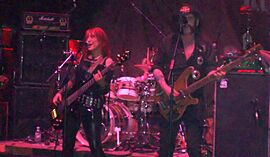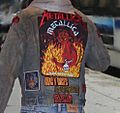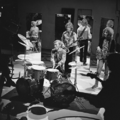Heavy metal music facts for kids
Quick facts for kids Heavy metal |
|
|---|---|
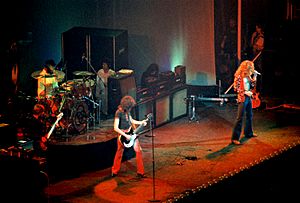
From left to Led Zeppelin performing at Chicago Stadium in January 1975
|
|
| Stylistic origins | Blues rock, Psychedelic rock, Hard rock |
| Cultural origins | Late 1960s/Early 1970s United Kingdom and United States |
| Typical instruments | Electric guitar, bass, drums, vocals |
| Subgenres | |
| Black metal - death metal - doom metal - folk metal - glam metal - gothic metal - power metal, progressive metal - speed metal - symphonic metal - thrash metal - viking metal (complete list) |
|
| Fusion genres | |
| Deathcore - grindcore - metalcore - nu metal | |
| Other topics | |
| Rock music | |
Heavy metal (or simply metal) is a genre of rock music that developed in the late 1960s and early 1970s, largely in the United Kingdom and United States. It has a thick, monumental sound characterized by distorted guitars, extended guitar solos, emphatic beats and loudness.
In 1968, three of the genre's most famous pioneers – British bands Led Zeppelin, Black Sabbath and Deep Purple – were founded. Several American bands modified heavy metal into more accessible forms during the 1970s: the raw, sleazy sound and shock rock of Alice Cooper and Kiss; the blues-rooted rock of Aerosmith; and the flashy guitar leads and party rock of Van Halen.
During the 1980s, glam metal became popular with groups such as Bon Jovi, Mötley Crüe and Poison. Meanwhile, however, underground scenes produced an array of more aggressive styles: thrash metal broke into the mainstream with bands such as Metallica, Slayer, Megadeth and Anthrax, while other extreme subgenres such as death metal and black metal became – and remain – subcultural phenomena. Since the mid-1990s, popular styles have expanded the definition of the genre. These include groove metal and nu metal, the latter of which often incorporates elements of grunge and hip-hop.
Contents
Characteristics
Heavy metal is traditionally characterized by loud distorted guitars, emphatic rhythms, dense bass-and-drum sound and vigorous vocals. Heavy metal subgenres variously emphasize, alter or omit one or more of these attributes. In a 1988 article, The New York Times critic Jon Pareles wrote, "In the taxonomy of popular music, heavy metal is a major subspecies of hard-rock—the breed with less syncopation, less blues, more showmanship and more brute force." The typical band lineup includes a drummer, a bassist, a rhythm guitarist, a lead guitarist and a singer, who may or may not be an instrumentalist. Keyboard instruments are sometimes used to enhance the fullness of the sound. Deep Purple's Jon Lord played an overdriven Hammond organ. In 1970, John Paul Jones used a Moog synthesizer on Led Zeppelin III; by the 1990s, synthesizers were used in "almost every subgenre of heavy metal".
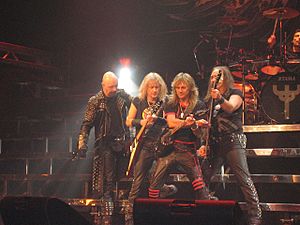
The electric guitar and the sonic power that it projects through amplification has historically been the key element in heavy metal. The heavy metal guitar sound comes from a combined use of high volumes and heavy fuzz. For classic heavy metal guitar tone, guitarists maintain gain at moderate levels, without excessive preamp or pedal distortion, to retain open spaces and air in the music; the guitar amplifier is turned up loud to produce the "punch and grind" characteristic. Thrash metal guitar tone has scooped mid-frequencies and tightly compressed sound with multiple bass frequencies. Guitar solos are "an essential element of the heavy metal code ... that underscores the significance of the guitar" to the genre. Most heavy metal songs "feature at least one guitar solo", which is "a primary means through which the heavy metal performer expresses virtuosity". Some exceptions are nu metal and grindcore bands, which tend to omit guitar solos. With rhythm guitar parts, the "heavy crunch sound in heavy metal ... [is created by] palm muting" the strings with the picking hand and using distortion. Palm muting creates a tighter, more precise sound and it emphasizes the low end.
The lead role of the guitar in heavy metal often collides with the traditional "frontman" or bandleader role of the vocalist, creating a musical tension as the two "contend for dominance" in a spirit of "affectionate rivalry". Heavy metal "demands the subordination of the voice" to the overall sound of the band. Reflecting metal's roots in the 1960s counterculture, an "explicit display of emotion" is required from the vocals as a sign of authenticity. Critic Simon Frith claims that the metal singer's "tone of voice" is more important than the lyrics.
The prominent role of the bass is also key to the metal sound, and the interplay of bass and guitar is a central element. The bass provides the low-end sound crucial to making the music "heavy". The bass plays a "more important role in heavy metal than in any other genre of rock". Metal basslines vary widely in complexity, from holding down a low pedal point as a foundation to doubling complex riffs and licks along with the lead or rhythm guitars. Some bands feature the bass as a lead instrument, an approach popularized by Metallica's Cliff Burton with his heavy emphasis on bass solos and use of chords while playing the bass in the early 1980s. Lemmy of Motörhead often played overdriven power chords in his bass lines.
The essence of heavy metal drumming is creating a loud, constant beat for the band using the "trifecta of speed, power, and precision". Heavy metal drumming "requires an exceptional amount of endurance", and drummers have to develop "considerable speed, coordination, and dexterity ... to play the intricate patterns" used in heavy metal. A characteristic metal drumming technique is the cymbal choke, which consists of striking a cymbal and then immediately silencing it by grabbing it with the other hand (or, in some cases, the same striking hand), producing a burst of sound. The metal drum setup is generally much larger than those employed in other forms of rock music. Black metal, death metal and some "mainstream metal" bands "all depend upon double-kicks and blast beats".
In live performance, loudness – an "onslaught of sound", in sociologist Deena Weinstein's description – is considered vital. In his book, Metalheads, psychologist Jeffrey Arnett refers to heavy metal concerts as "the sensory equivalent of war". Following the lead set by Jimi Hendrix, Cream and the Who, early heavy metal acts such as Blue Cheer set new benchmarks for volume. As Blue Cheer's Dick Peterson put it, "All we knew was we wanted more power." A 1977 review of a Motörhead concert noted how "excessive volume in particular figured into the band's impact". Weinstein makes the case that in the same way that melody is the main element of pop and rhythm is the main focus of house music, powerful sound, timbre and volume are the key elements of metal. She argues that the loudness is designed to "sweep the listener into the sound" and to provide a "shot of youthful vitality".
Heavy metal performers tended to be almost exclusively male until at least the mid-1980s, with some exceptions such as Girlschool. However, by the 2010s, women were making more of an impact, and PopMatters' Craig Hayes argues that metal "clearly empowers women". In the power metal and symphonic metal subgenres, there has been a sizable number of bands that have had women as the lead singers, such as Nightwish, Delain and Within Temptation.
Musical language
Rhythm and tempo

The rhythm in metal songs is emphatic, with deliberate stresses. Weinstein observes that the wide array of sonic effects available to metal drummers enables the "rhythmic pattern to take on a complexity within its elemental drive and insistency". In many heavy metal songs, the main groove is characterized by short, two- or three-note rhythmic figures – generally made up of eighth or 16th notes. These rhythmic figures are usually performed with a staccato attack created by using a palm-muted technique on the rhythm guitar.
Brief, abrupt and detached rhythmic cells are joined into rhythmic phrases with a distinctive, often jerky texture. These phrases are used to create rhythmic accompaniment and melodic figures called riffs, which help to establish thematic hooks. Heavy metal songs also use longer rhythmic figures such as whole note- or dotted quarter note-length chords in slow-tempo power ballads. The tempos in early heavy metal music tended to be "slow, even ponderous". By the late 1970s, however, metal bands were employing a wide variety of tempos, and as recently as the 2000s, metal tempos range from slow ballad tempos (quarter note = 60 beats per minute) to extremely fast blast beat tempos (quarter note = 350 beats per minute).
Harmony
One of the signatures of the genre is the guitar power chord. In technical terms, the power chord is relatively simple: it involves just one main interval, generally the perfect fifth, though an octave may be added as a doubling of the root. When power chords are played on the lower strings at high volumes and with distortion, additional low-frequency sounds are created, which add to the "weight of the sound" and create an effect of "overwhelming power". Although the perfect fifth interval is the most common basis for the power chord, power chords are also based on different intervals such as the minor third, major third, perfect fourth, diminished fifth or minor sixth. Most power chords are also played with a consistent finger arrangement that can be slid easily up and down the fretboard.
Typical harmonic structures
Heavy metal is usually based on riffs created with three main harmonic traits: modal scale progressions, tritone and chromatic progressions, and the use of pedal points. Traditional heavy metal tends to employ modal scales, in particular the Aeolian and Phrygian modes. Harmonically speaking, this means the genre typically incorporates modal chord progressions such as the Aeolian progressions I-♭VI-♭VII, I-♭VII-(♭VI), or I-♭VI-IV-♭VII and Phrygian progressions implying the relation between I and ♭II (I-♭II-I, I-♭II-III, or I-♭II-VII for example). Tense-sounding chromatic or tritone relationships are used in a number of metal chord progressions. In addition to using modal harmonic relationships, heavy metal also uses "pentatonic and blues-derived features".
The tritone, an interval spanning three whole tones – such as C to F# – was considered extremely dissonant and unstable by medieval and Renaissance music theorists. It was nicknamed the diabolus in musica – "the devil in music".
Heavy metal songs often make extensive use of pedal point as a harmonic basis. A pedal point is a sustained tone, typically in the bass range, during which at least one foreign (i.e., dissonant) harmony is sounded in the other parts. According to Robert Walser, heavy metal harmonic relationships are "often quite complex" and the harmonic analysis done by metal players and teachers is "often very sophisticated". In the study of heavy metal chord structures, it has been concluded that "heavy metal music has proved to be far more complicated" than other music researchers had realized.
Images for kids
-
Ritchie Blackmore, founder of Deep Purple and Rainbow, known for the neoclassical approach in his guitar performances.
-
Kiss performing in 2004, wearing makeup
-
A heavy metal fan wearing a denim jacket with band patches and artwork of the heavy metal bands Metallica, Guns N' Roses, Iron Maiden, Slipknot, Dio and Led Zeppelin.
-
Led Zeppelin performing at Chicago Stadium in January 1975
-
Brian Robertson, Phil Lynott, Scott Gorham of Thin Lizzy performing during the Bad Reputation Tour, 24 November 1977
-
Iron Maiden, one of the central bands in the new wave of British heavy metal
-
Layne Staley of Alice in Chains, one of the most popular acts identified with alternative metal performing in 1992
See also
 In Spanish: Heavy metal para niños
In Spanish: Heavy metal para niños


